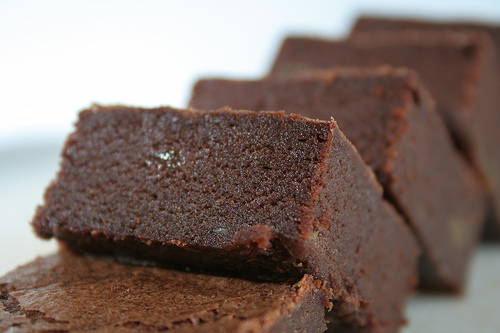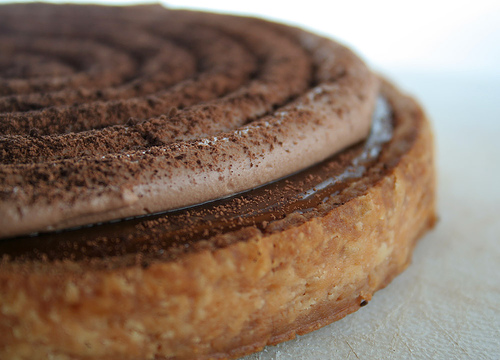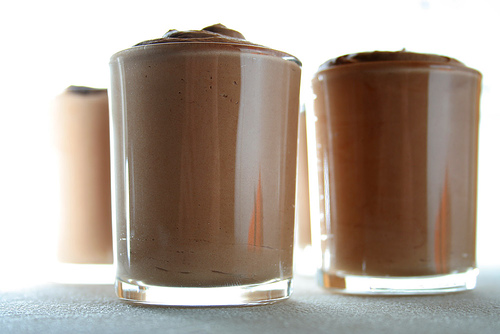-
Posts
2,351 -
Joined
-
Last visited
Content Type
Profiles
Forums
Store
Help Articles
Posts posted by Patrick S
-
-
Very clever pal. Volume to weight? I'm impressed. It sure works for things with known densities (water, salt, sugar..etc..).
What kind of algorithm are you using for the rest?
My guess would be that he(?) measures out a cup, and then weighs it.
-
Only problem is that a liter is not a liter the world around. . .
Are you sure? I thought a liter was precisely 1000cc the world around.
-
I know this was a recent thread, so I decided so see if we could make a contribution. We've put together an ingredient conversion calculator, and I'd appreciate any comments/suggestions. I know that "a pint's a pound the world around" but there's plenty of room for discussion when you work with teaspoons and tablespoons. We're using grams in a cup for our foundation, and going from there. Please play with it, and let me know if you have some suggestions. You can find it at: http://www.recipesonrails.com/conversions
Great work! This is a great resource.
One thing I would suggest is that you specify the method of measuring for those ingredient where the measuring method matters. For instance, you list 113g as the weight for a cup of AP flour, however the weight of a cup of flour will vary quite a bit depending on how you measure it. Many recipes specify weighing the flour by the dip and sweep method, which will give you a cup weighing about 143 grams.
-
1. What's the best way to get a thinner caramel coating on my puffs?
Keep the caramelized sugar very hot -- the hotter it is, the thinner it will be, and the less will adhere. That's the only thing I can think of.
-
I'm surprised to read those quotes re: canned v. fresh pumpkin puree.
I use fresh pumpkin (and sweet potatoes) quite a bit; the only thing remotely difficult is splitting them down the middle when raw (I use a rubber mallet, a cleaver and the hope that I will retain all my digits).
I don't think any of the people I quoted made it out to be difficult, at east not in the sense of being technically challenging or requiring some arcane culinary expertise. But obviously it is much more work, much more time-consuming, and since time is money for many of us, and since canned pumpkin is so inexpensive, using fresh pumpkin is probably more expensive as well. I'm actually eager now to try for myself, and see if fresh pumpkin really is as superior as some people are making it out to be.
-
Or is invertase combined with sugar and that creates invert sugar?
That's right-- you can use invertase to make your own invert sugar if you wanted to.
-
Not sure that Invertase is used much anymore. Much easier just to freeze the liquid centre before dipping.
Old style liquor chocs have the liquor in a sugar shell.
I have checked the ingredients on several different brands of cordial cherries --cheap brands, not high end-- and they all list invertase on the ingredients label.
-
And is it worth the effort? Will the taste be that much better?
I haven't tried using fresh pumpkin, but I've read several accounts from other people who have said that, no, fresh pumpkin is not better, and is basically a waste of time. For instance, one individual here stated that:
The one time that I made a pumpkin pie starting with a fresh pumpkin, I was very disappointed. Not only did it NOT taste any better than the canned pumpkin, but it was a tremendous amount of work. Despite my best efforts, it ended up with a slightly gritty texture due to the high fiber content of the pumpkin. To be fair, however, I was probably not using the right variety of pumpkin.In another article, a cookbook author is quoted thus:
“After trying a couple of times to make pies with ‘from scratch’ pumpkin puree (cutting, roasting, scraping, mashing), I concluded that it’s really not worth the trouble — in fact, canned pumpkin is superior in some ways because the puree has been cooked down to a properly thick consistency,” James Beard Award-winning cookbook author Brooke Dojny writes in her latest book, “Dishing up Maine.”A direct comparison is reported here. The author says:
With this in mind, Libby's Famous Pumpkin Pie became the control recipe of the fresh vs. canned duel. I cooked the fresh pumpkin according to the succinct directions of Farm Journal's Complete Pie Cookbook. . .The fresh purée was yellow-gold and watery, almost pallid. It smelled vaguely of retirement-home cafeterias; its mouth feel echoed baby food, with a slightly chalky finish. The flavor? Bland.
The purée from the can, meanwhile, was an alluring, saturated orange-red. Its aroma was familiar, almost primal, calling to mind everything that is autumn: vibrant leaves crackling under your feet on the sidewalk; the buttery yellow crescent of a moon holding water over a cornfield. Compared to the wan fresh purée, the canned purée was rich, almost spicy, with a subtle sweetness and depth . . . Both pies were delicious, but Libby's was one degree more intense in every department: taste, texture, bouquet.
Of course your experience may certainly vary, and I hope you'll report back if you go through the trouble of making your own puree.
-
I was looking for something quick to make the other night, so I made the "French" brownies. These are very buttery, have rummy raisins and just a little cinnamon. Everyone liked them.

-
-
Incidentally, if anyone wants to check the accuracy of their scales, they can do so using coins -- according to the US mint, new pennies, nickels, dimes and quarters weigh 2.500g, 5.000g, 2.268g and 5.670 g, respectively. So, for instance, 20 nickels should weigh out to 100g.
that's a great tip. it's too bad that they don't have more specific weights for dimes and quarters, i.e. dimes 2.25 and quarters 5.5 or 5.75...
Well, the weights might be arbitrary, but they are specified to 1/1000 of a gram -- I'd say that's pretty specific!

-
Incidentally, if anyone wants to check the accuracy of their scales, they can do so using coins -- according to the US mint, new pennies, nickels, dimes and quarters weigh 2.500g, 5.000g, 2.268g and 5.670 g, respectively. So, for instance, 20 nickels should weigh out to 100g.
-
probably a good idea patrick, but it would have to be a list in one post that can be edited by a moderator or manager that can be kept pinned as a reference. that way, you wouldn't have to search through a whole thread of people debating the weight of a cup of flour in order to find one measurement.
there will still be debate though.
Sure, as long as people are using slightly different measuring cups and different scales and different measuring techniques, slightly different weights will be reported. That's not a problem. In every case I've encounted so far, the variability from person to person has been pretty insignificant. Also, if we did create such a list, I think it would be best to take the accuracy of people's scales into account, so that a value reported by someone with a scale with an accuracy of, say, 0.2 grams, could be given more weight than a similar weight reported by someone with a scale with an accuracy of 2 grams.
-
But I did, and found that it appears that zebra milk is being considered (apparently, I am never really sure of fully understanding anything that is written about science or medicine) in cancer cures.
Here is one site that discusses this:Townsend Letter for Doctors and Patients
We have put Helios Pharmacy on notice that as soon as a proving is done on zebra's milk, we are waiting to prescribe it (no joke)!Wow. Now I am completely flummoxed.
 I have no idea what to think.
I have no idea what to think. 
Well, the article you link to was written by a homeopath, not what most of us would consider a real doctor. FWIW, the vast majority of physicians and medical researchers do not consider homeopathy to have any kind of scientific basis, or homeopathic remedies to have any therapeutic efficacy beyond that normally associated with placebos.
-
I also think that if you look outside of the sphere of American cake recipes, sugar is used more sparingly. . . some Japanese recipes I've seen used little more than an ounce of sugar for a whole cake that would likely have four times as much sugar in the typical American incarnation.
That's funny, because when I think "Japanese cake," I think of kasutera, which I happen to love but which is about as "tooth-achingly sweet" as any cake I've tried.
-
These questions come up so frequently, wouldn't it be helpful if we devoted a thread just to listing weights for various ingredients?
-
RLB lists 4.5oz/135g per dip-and-sweep cup for cake flour, and that's the value I always use, unless the recipes specifies a different measuring method. I double-checked just now and got 133g.
-
Which do everyone follow..the lightly spooned OR dip and sweep?
If the method is not specified in the recipe, I always assume 1C AP flour weighs 5oz/145 grams.
-
Where I have double-checked, RLB has been accurate. I wouldn't worry too much about a couple of grams here and there if you're considering an ingredient like flour or sugar.
-
Gorgeous as always, Patrick. Your crust looks amazing -- is it a pate sucree, or a standard pie crust, or what?
Thanks, Ruth. The crust is actually some of Dorie's good-for-Almost-Anything pie crust, which I already had in the freezer.
-
One baking book I own suggests using a processor, then putting the chopped almonds through a sieve, then rechopping the the pieces that did not go through. You repeat until the remaining pieces are too smal a batch to be effectively chopped. This method is obviously really good at getting a consistent particle size.
My recollection from some old posts here is that real almond flour is processed by an entirely different method in which the almonds are crushed and the oils eliminated, so no home method is going to be able to precisely reproduce this.
This I learned is school -- true almond flour is the crush of what is left after the almond oil extraction. Almond meal is just the pulverized whole almond. I've never seen true almond flour in a grocery store. Bob's Red Mill is labeled as Almond Meal/Flour.
For which applications would you want oil-less ground almonds? I've used homemade almond flour in many financier and macaron recipes, with no problems, so I'm curious what the advantage of "true" almond flour is supposed to be.
-
I made a caramel tart with milk chocolate mousse spiral on top. I had some mousse left over, which I piped into little glasses.


-
Plus, Dorie, if you can respond..the recipe seems to be missing a sentence on when to fold in the egg whites...I know it is at the end, but does not say specifically. Also, you fold whatever flavoring in at the end, too..different than in nightscotsman. So, looking for reviews!! Thanks.
To expand on what Dorie said, just whip the whites to firm, glossy peaks while the syrup is coming up to temp. When the syrup is ready, beat it into the already-beaten whites.
-
Then simmer it for fifteen minutes to destroy any toxins made by the bacteria.
Wait, so you're saying that it is possible to destroy the toxins produced by the bacteria? I have not heard that before. I thought the toxins were fairly safe from the effects of heat.
Bacterial toxins vary in their thermostability. Some are destroyed by boiling and some are not. As I pointed out above, some bacterial toxins (such as those produced by Staphylococcus aureus) are extremely heat-stable, and will not be destroyed even by hours of boiling.



Ingredient conversions
in Cooking
Posted
Well, its true that you will never completely eliminate measurement error (e.g. one person's cup might be a fraction of a millileter larger than another, or one person's scale might be more accurate), but I would say that you could certainly reduce it to a point where it becomes almost meaningless. I dont know if there is a way for you to do this with your system, but it would good if there were some way to give greater weight (pun intended) to measurements that are of higher quality. For instance, a measurement that specifies the volume of the cup precisely (say, 225ml), and uses a scale with an accuracy of 0.1gram, would be worth more than 50 measurements where the cup's volume is not defined precisely (it could be anywhere from 200-250ml), and the scale has an accuracy of 2g. This is one reason why I tend to use the conversions in The Cake Bible -- the author specifies the scale she used (an extremely accurate Mettler lab scale), the volume of the cup she used (236ml), and, where applicable, the method that was used to fill the cup (sifted into cup, spooned into cup, dip-and-sweep into cup).